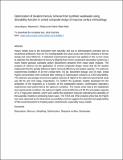Optimization of divalent mercury removal from synthetic wastewater using desirability function in central composite design of response surface methodology

View/
Date
2023-12-07Author
Bayuo, Jonas
Rwiza, Mwemezi
Mtei, Kelvin
Metadata
Show full item recordAbstract
Heavy metals exist in the ecosystem both naturally and due to anthropogenic activities and as recalcitrant pollutants; they are non-biodegradable and cause acute and chronic diseases to human beings and many lifeforms. A statistical experimental approach was applied in this current study to optimize the detoxification of mercury [Hg(II)] from mono-component biosorption system by a novel hybrid granular activated carbon (biosorbent) prepared from maize plant residues. The analysis of variance by the application of central composite design shows that all the studied independent factors greatly influence Hg(II) removal efficiency and uptake capacity. The optimum experimental condition of 30 min contact time, 0.5 g/L biosorbent dosage, and 15 mg/L initial Hg(II) concentration were achieved after seeking 20 optimization solutions at 0.903 desirability. The optimum percentage removal and uptake capacity of Hg(II) at the optimal experimental setup was 96.7% and 10.8 mg/g, respectively. To confirm the quadratic models developed for the prediction of the responses as a function of the independent factors, confirmatory laboratory experiments were performed at the optimum condition. The results show that at the established best experimental condition, the optimum Hg(II) removal efficiency of 98.3% and uptake capacity of 11.2 mg/g were attained, which were within the prediction intervals indicating the suitability of the quadratic models in predicting future cases. The TEM and XRD analyses show that the Hg(II) ions were adsorbed by the biosorbent successfully and this suggests the potential and applicability of this novel biosorbent in treating water contaminants, especially heavy metals.
URI
https://doi.org/10.1007/s40201-023-00888-5https://dspace.nm-aist.ac.tz/handle/20.500.12479/2803
